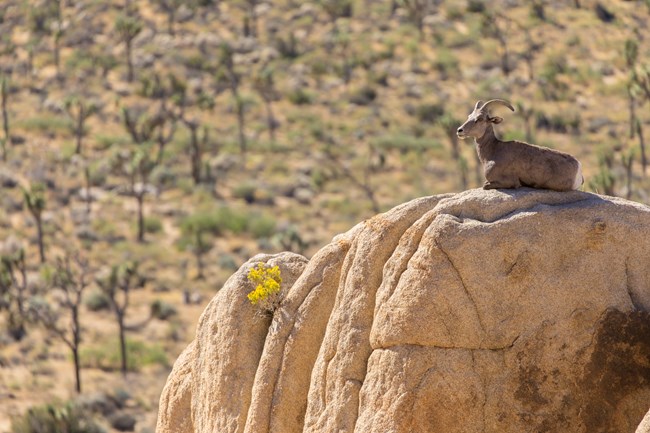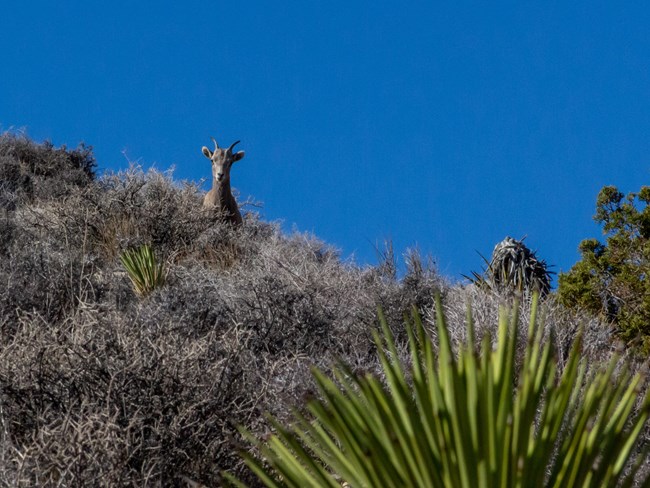
NPS / Glauco Puig-Santana The desert bighorn, Ovis canadensis nelsoni, ranges through the dry, desert mountains of eastern California, much of Nevada, northwestern Arizona, and southern Utah. Across its entire range, the total population is about 13,000. It is estimated that 100 to 200 bighorn live in Joshua Tree National Park. DescriptionMale sheep, called rams, often weigh over 200 pounds. They can be recognized by their massive brown horns. The horns curl back over the ears, down and up past the cheeks. By the time a ram is seven or eight years of age, he can have a set of horns with a full curl, a spread of 30 inches, and a weight of almost 30 pounds. Horn size is a symbol of rank in the herd. However, many rams rub off the ends of their horns (called "brooming") because they interfere with their vision. Ewes, the females, are smaller than rams and have shorter, smaller horns that never exceed half a curl. Ewes seldom venture from their natal herd, but rams wander rather frequently. HabitatDesert bighorn prefer a habitat of steep, rocky terrain for escape from predators, bedding, and lambing. Bighorn zigzag up and down cliff faces with amazing ease. They use ledges only two inches wide for foot holds, and bounce from ledge to ledge over spans as wide as 20 feet. They can move over level ground at 30 miles per hour and scramble up mountain slopes at 15 mph. They are aided by cloven hooves which are sharp-edged, elastic, and concave. The bighorn uses open areas of low growing vegetation near rugged terrain for feeding. This habitat preference divides Joshua Tree's bighorns into three more or less separate areas or ranges. The Eagle Mountains at the far easterm portion of the park is concentrated around the Cottonwood and Lost Palms oases. The second area ranges through the main part of the Little San Bernardino Mountains (includes Keys View). The last area is found in the Wonderland of Rocks and Queen mountain. Members of this last group are the ones most often seen by park visitors. Learn more about Desert Bighorn Sheep populations, what challenges they face, and how they connect desert landscapes by following this link. FoodBighorn graze on a wide variety of plant species for food. Green grasses are preferred, but when this food is not available, as is the case for most of the year in Joshua Tree, they feed on a variety of other plants, including cacti. Bighorns have a complex nine-stage digestive process that allows them to maximize removal of nutrients from their food. 
NPS / Bill Bjornstad ActivityThe desert bighorn is most active during daylight, moving to traditional bedding areas at night. During the summer bighorn rest during the hot midday, often on cliffs above their water source. Rest periods are also used for chewing cud. Water is critical to bighorn survival. In early spring of years with good winter rains they get enough water from the grass they eat to go without drinking. At other times they must trek to a spring or water-holding depression at least every third day. Lactating ewes need to drink almost every day. Making the trek to water is the most dangerous part of a bighorn's life. It is in the narrow canyons, where most springs occur, that the adult sheep's only significant predator, the mountain lion, Felis concolor, lies in wait. Most dead sheep found in the park are mountain lion kills. Life HistoryLike all sheep, bighorn are gregarious, sometimes forming herds of over 100 individuals, but small groups of eight to 10 are more common. For most of the year, mature rams stay apart from females and the young in separate bachelor bands. Rams do not defend territories but do engage in battles over mating access to a particular female. Overall vigor as well as horn size determines male dominance status. Rutting may occur at any time of year but seems to peak in August and September. Gestation lasts 150 to180 days. Desert bighorn may give birth at any season, but most births occur from January to April. Twins are rare. Within a few weeks of birth, lambs form bands of their own, seeking out their mothers to suckle only occasionally. By six months of age, they are completely weaned. Only about one-third of the lambs survive the rigor of their first summer. Ewes are usually ready to breed in their second or third year. Males reach sexual maturity at the same age but are not usually strong enough to compete for mating until they are seven years old. After reaching adulthood, most bighorn live over 10 years, with maximum life span being 20 years. ConservationThe Desert bighorn population today is only about 10 percent of what existed before the settlement of the West. This species is extremely sensitive to disease. Like the native humans with whom it shared the southwest for thousands of years, it has little resistance to the diseases of European sheep and cattle. Disease contracted from domestic livestock may be the major factor in decline and loss of populations. Wild horses and burros also compete with Desert bighorns for water and forage in much of their range. In 2015, a sick bighorn was spotted and later found dead inside the park. The carcass was collected and submitted for disease testing. The bighorn tested positive for a contagious bacterial infection that causes pneumonia and often leads to death. Recent research in Joshua Tree has shown a significant loss of open water in the form of springs and seeps. This loss of water, especially during the hot and dry summer months has contributed to a significant loss of available habitat. We are also researching the movement patterns of bighorn sheep by collaring a small number of bighorn in areas frequented by visitors. This data will show how bighorn behave with the recent and dramatic increase in visitation to the park. |
Last updated: February 12, 2024
